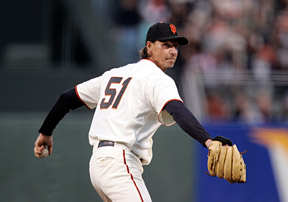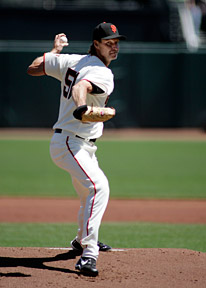What keeps a professional athletic team playing at the top of its game? If you ask the San Francisco Giants baseball team, part of their response would include giving credit to acupuncture and Oriental medicine.
If the Giants' season thus far is any indication, Ogawa certainly would appear to be helping the team achieve phenomenal results. As of June 15, the Giants were in second place in the National League West, only seven games behind the Los Angeles Dodgers. They were riding a three-game winning streak, had won seven of their last 10 games, and were in serious contention for a wild-card playoff spot. A large part of their success was due to Ogawa's 46-year-old star client and future Hall-of-Famer, Randy "The Big Unit" Johnson.
Ogawa said that Johnson had never tried acupuncture before this season. The results have been impressive. A five-time Cy Young Award winner, Johnson is well past the time when most pitchers retire. Yet, he carried a winning record into the end of June and hadn't missed a start. While he may not be able to throw 100-mph fastballs like he could in his prime, he is still averaging more than eight strikeouts per nine innings pitched.
 San Francisco Giants starting pitcher, Randy Johnson, shows his hard-throwing moves.
San Francisco Giants starting pitcher, Randy Johnson, shows his hard-throwing moves.
Credit: ©2009 S.F. Giants
David Groeschner, head athletic trainer for the Giants, told Acupuncture Today that Ogawa's work with the players has been great. "The players love him and love the treatments. In our game, we are out there every day, so the players get sore and banged up. They definitely get back into the game more quickly because of his work."
In an exclusive interview with Acupuncture Today, Ogawa took time out of his busy schedule of both home and away games to talk about how Eastern medical traditions can provide benefit to players of one of the most Western sports imaginable.
AT: Tell me what a typical day working for the Giants might be like?
HO: We have 81 home games and 81 road trips. I am with them for all their games starting from April and going to the end of September. I also work with them during spring training in Scottsdale, Ariz., which takes place from last half of February through the end of March. My working hours are usually from 1 pm until the end of the game. I also teach acupuncture techniques at AIMC Berkeley in the mornings when we have home games.
AT: What are your various duties for the team?
HO: My position is as a massage therapist and acupuncturist for the team. However, I am also a certified athletic trainer. I am always communicating with the athletic trainers and team staff.
AT: How did you get started working in sports acupuncture?
HO: The first offer I got was from a Japanese baseball team. This was like those teams in the industrial League (amateur workers' teams in Japan, not affiliated with major-league baseball) because I was able to work not only as an acupuncturist, but also as a strengthening coach and an athletic trainer.
 San Francisco Giants starting pitcher, Randy Johnson, stays in the game with acupuncture.
San Francisco Giants starting pitcher, Randy Johnson, stays in the game with acupuncture.
Credit: ©2009 S.F. Giants
AT: What acupuncture techniques do you use?
HO: My technique is based on Japanese meridian therapy. My treatments are basically the same for every sport because meridian therapy is a balance treatment. It increases the human immune system and also enhances the healing process, as well as protecting the body from injuries. My specialties are decreasing muscle tension and pain management for the lower back and shoulder-girdle problems.
AT: What sort of advice would you offer to other acupuncturists wishing to get into working with professional sports teams/athletes?
HO: My advice would be to get to know human movement and kinesthetic studies in sports medicine, especially for the specific sport in which you wish to work. You must be able to work and communicate with Western health care professionals such as the team medical doctor and the physical therapist, as well as with the athletic trainer, using the same terminologies that they understand. I would also advice being able to fit in well with the sports-medicine team
AT: What are some of the typical injuries that you see and treat as a sports acupuncturist?
HO: The most typical injuries I treat are muscle strain and stress management.
 San Francisco Giants starting pitcher, Randy Johnson, getting ready to throw another winning ball.
San Francisco Giants starting pitcher, Randy Johnson, getting ready to throw another winning ball.
Credit: ©2009 S.F. Giants
AT: Focusing on baseball: Is acupuncture particularly helpful in any specific injury types, i.e., a wrist injury or a sore throwing arm?
HO: Acupuncture is helpful for lower back pain, muscle strain on hamstrings and muscle tightness on the shoulder girdle. These are all typical injuries in baseball.
AT: Can you share with our readers one of your success stories in treating an athlete?
HO: I have been treating one of the team's starting pitchers, Randy Johnson. On June 4, against the Washington Nationals, he earned his 300th win. He is the 24th pitcher to reach that goal, and the second-oldest to do so. He's also only the sixth left-handed pitcher to have won 300 games.
AT: What are some of the biggest rewards about working as a sports acupuncturist?
HO: The thing that makes me the happiest is when a player tells me, "Thank you very much," or "You are the best!" It means a great deal to earn trust from the ballplayers and the team as a whole; to be considered as one of the most important people in their sports-medicine team.
AT: Anything else you'd like to add?
HO: There are not many acupuncturists working in major-league baseball. So we need to educate people that acupuncture works well in sports medicine. We need to communicate with the other staff on the medical team using the same medical terminology. It is very important that we show how we an fit into the medical team.



